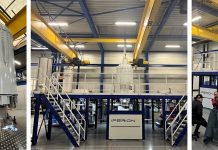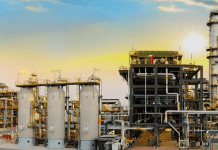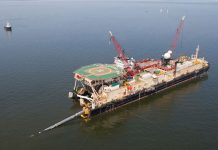Text by Mike Porfilio & Robert Uitz, Photos by Jesse Binder
___
The inconvenient truth – welding of castings
We need to ask ourselves, why a casting? A casting is many things to many people. Firstly, a casting is an economic preform. By this, I mean that it is a shape made in sand or an investment mould. Many shapes are only possible to make with this process.
Take a complex pump casing with many passages and blind holes as well as a thin cut water feature; these features cannot be made economically as a forging or from a wrought block of steel. A casting is superior due to its equiaxed grain structure and is much more corrosion resistant than a wrought material of a similar shape.
An important benefit of a cast product is that it is weldable, as compared to other manufacturing techniques.
A disadvantage is that the casting may not have the same strength or wear resistance as a forging or other form. As long as the design is correct for the application, a sound casting can be beneficial as an economic preform (saving you the time and cost of machining from a larger shape as well as expensive tool costs). Weld upgrading is part of the process of producing a casting of high integrity as well as commercial items.
Common welding techniques are used in a foundry to weld casting defects such as sand inclusions, shrinkage porosity or other foundry defects. Welding processes such as shielded metal arc welding (SMAW), gas tungsten arc welding (GTAW) and flux-cored arc welding (FCAW) are a few of the common techniques used (Table 1).
Welding technique |
Pros to welding technique |
Cons to welding technique |
| Gas tungsten Arc welding – GTAW |
• Very precise weld beads • Cost-effective to perform the small welds • Ability to perform autogenous welds (no filler) |
• Very hot process and can create stress and cracking at times • Specialized process, not a time saver • Requires a high skill level |
| Shielded metal Arc welding – SMAW |
• Very cool welds can be produced for low cracking potential • Many electrodes available for many different types of stainless steels |
• Requires a lot of cleaning and chipping of weld slag • Electrodes require constant reloading into the holder |
| Gas Metal Arc welding – GMAW |
• Simple process to train new welders • The process can apply tremendous amounts of welds quickly |
• Can produce gas prone welds • Not allowed for some welding codes and project • Can be difficult to qualify welders to due to being a sensitive process (gas, lack of fusion) |
| Flux core Arc welding – FCAW |
• The process can apply tremendous amounts of welds quickly • A consistent process producing very clean welds • Shielding gas leaves weld zones needing minimal cleaning. |
• More expansive as more filler material is needed • Welds on thinner materials are more difficult to manage |
Welding codes
Welding is permitted and endorsed by practically all materials codes. All American material codes such as ASTM A351, A487 and A995, to reference a few, allow minor and major welding of castings. European material codes such as EN10213 have welding allowances for repair or upgrade activities. Welding being an engineering centric process requires controlled oversight concerning repair or upgrade on castings through technical codes and specifications.
There are essential, supplementary essential and non-essential variables referenced in the American Society of Mechanical Engineers (ASME) codes. The American Society of Materials Testing (ASTM) also has welding conditions that need to be complied with. European welding codes carry requirements for tensile strength and weldability tests such as weld bends.
Many of these tests are common to both American and European specification agencies. Together these create verifications and compliances to ensure safety, metallurgical integrity and a standardised process. Personnel qualifications for welders and welding operators are tightly woven into the codes and norms that regulate good welding practice and technique.
In many instances, welders must undergo performance tests before they are allowed to perform welding and casting repair to establish confidence in their performance. Radiography, visual inspection and/or weldability tend to be the standard tests that are performed for all welding codes.
Tools and methods for weld repair
After a casting has been inspected and defective areas have been marked, these locations need to be excavated. To perform a proper weld the weld area needs to be cut or ground down to sound metal. Figure 2 shows some of the tools used to perform this cleaning and weld excavation preparation. One of the most useful tools to excavate with is a heliarc torch. The area of interest can be swiped free of defects, burrowing down until clean metal has been obtained. Another technique employed is an abrasive wheel which grinds the pocket clean. Additional tools which can be useful include carbide burrs and abrasive stones. All of these will polish an excavation and prepare it for welding.
Filler materials
Filler materials that are used to perform the welds on castings are tightly restricted and held to industry standards. Whether it be a filler material for GTAW which uses a bare rod or wire, or SMAW coated electrode, there are many tests that are performed to ensure compliance with standards. Tests to qualify weld materials include tensile, radiography, chemical analysis and others. These filler materials typically align with the base material in terms of strength and chemical makeup.
Welding technique
The act of welding is more science than art and following the required welding procedures is essential. A steady hand is required to keep arc at appropriate distances while maintaining specified interpass temperatures and travel speeds, torch angles and other variables (Figure 3). Each technique is challenging but the GTAW process is most process sensitive.
Pre-welding activities
Additional types of tests as required by specification or standard must be performed. Documentation of weld orientation and the sizes of the welds, metallurgical tests, and non-destructive tests may be required. These tests or inspections tend to qualify the post-weld heat treatment or the integrity of the welds (volumetrically or surface conditions to ensure a crack-free surface).
Post-welding activities
Most material codes have very specific techniques that must be followed for post-welding activities. Many of the welding codes (ASME, ASTM, EN, AWS, etc.) require some of the following:
- Post weld heat treatment/solution treatment
- Pickling and passivation
- NDT activities – Radiography (RT), Liquid penetrant (PT), Visual inspection (VT)
- Metallurgical testing – Hardness,Tensile, Impact
- Special welding documentation or special welder qualifications
Good metallurgic practice on any type of cast austenitic/ferritic stainless steel would be to perform a proper heat treatment that re-establishes the grain structure and keeps carbide networks off of the grain boundaries. You cannot afford to have a brittle or less corrosive condition present, known as the Sigma phase. Sigma phase is combated easily with an appropriate post-weld heat treatment.
In addition to proper post-heat treatment, cleaning of the entire casting or the welded surface is required. Typically, proper alumina oxide blasting begins the cleaning process. Other abrasive media can be used such as stainless steel cut wire, or steel shot, depending on the alloy. At times further cleaning such as pickling is required or specified.
Pickling is an aggressive cleaning process involving the immersion of castings into a pickling solution which is typically a Nitric or Nitric-Hydrofluoric acid heated solution. This solution will flake off any additional left over heat treatment scale and surface free iron. Once clean, castings may be passivated by immersing in Nitric acid heated for approx.. 30 minutes. This sets the passive layer and greatly enhances corrosion resistance.
Conclusions
Preparation for welding, welding activities and inspection of welds as we have seen requires attention to detail. The production of ferrous and non-ferrous cast materials that require welding can vary vastly depending upon the material grade and the complexity of the cast shape. Taking care to have options and adherence to detail is key for successful upgrades and welds on commercial and high specification castings.
Properly trained and qualified welders who adhere to welding procedures, and guidelines that augment the casting process, allow foundries to meet their delivery deadlines. Welding continues to be a viable, proper and strong method to repair castings, and specifically cast stainless steels.
About the authors
Robert (Bob) Uitz
has spent his career at Stainless Foundry & Engineering, Inc. He began in 1978 with the hands-on operation of grinding high alloy castings for welding. Bob moved into welding operations and learned to weld all of the alloys offered. He has been part of the Manufacturing Supervision Team and is currently the Welding Program Coordinator. He is certified to Level II Visual and Liquid Penetrant and is a Quality Systems Lead Auditor.
Michael Porfilio
has worked in the American foundry industry since 1980. His background is in the fields of Metallurgy, Quality Management, Sales, and Marketing as well as Operations Management. He currently a Certified Nuclear Quality Systems Auditor and an NDT Level III. He is employed at Stainless Foundry & Engineering, Inc. as Director of Quality and Engineering and also performs consulting in the business, quality and materials arena.








